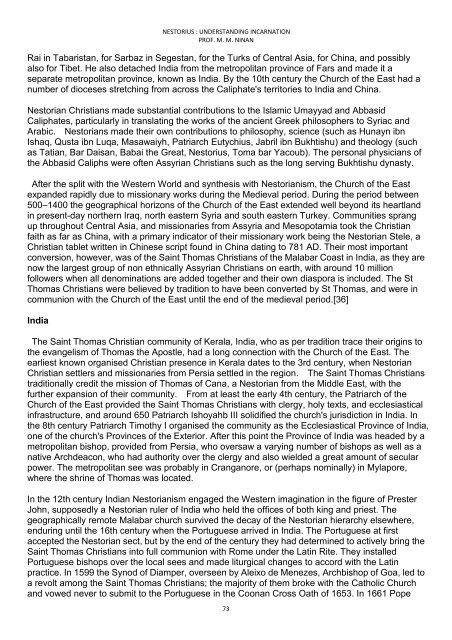Nestorius
Create successful ePaper yourself
Turn your PDF publications into a flip-book with our unique Google optimized e-Paper software.
NESTORIUS : UNDERSTANDING INCARNATION<br />
PROF. M. M. NINAN<br />
Rai in Tabaristan, for Sarbaz in Segestan, for the Turks of Central Asia, for China, and possibly<br />
also for Tibet. He also detached India from the metropolitan province of Fars and made it a<br />
separate metropolitan province, known as India. By the 10th century the Church of the East had a<br />
number of dioceses stretching from across the Caliphate's territories to India and China.<br />
Nestorian Christians made substantial contributions to the Islamic Umayyad and Abbasid<br />
Caliphates, particularly in translating the works of the ancient Greek philosophers to Syriac and<br />
Arabic. Nestorians made their own contributions to philosophy, science (such as Hunayn ibn<br />
Ishaq, Qusta ibn Luqa, Masawaiyh, Patriarch Eutychius, Jabril ibn Bukhtishu) and theology (such<br />
as Tatian, Bar Daisan, Babai the Great, <strong>Nestorius</strong>, Toma bar Yacoub). The personal physicians of<br />
the Abbasid Caliphs were often Assyrian Christians such as the long serving Bukhtishu dynasty.<br />
After the split with the Western World and synthesis with Nestorianism, the Church of the East<br />
expanded rapidly due to missionary works during the Medieval period. During the period between<br />
500–1400 the geographical horizons of the Church of the East extended well beyond its heartland<br />
in present-day northern Iraq, north eastern Syria and south eastern Turkey. Communities sprang<br />
up throughout Central Asia, and missionaries from Assyria and Mesopotamia took the Christian<br />
faith as far as China, with a primary indicator of their missionary work being the Nestorian Stele, a<br />
Christian tablet written in Chinese script found in China dating to 781 AD. Their most important<br />
conversion, however, was of the Saint Thomas Christians of the Malabar Coast in India, as they are<br />
now the largest group of non ethnically Assyrian Christians on earth, with around 10 million<br />
followers when all denominations are added together and their own diaspora is included. The St<br />
Thomas Christians were believed by tradition to have been converted by St Thomas, and were in<br />
communion with the Church of the East until the end of the medieval period.[36]<br />
India<br />
The Saint Thomas Christian community of Kerala, India, who as per tradition trace their origins to<br />
the evangelism of Thomas the Apostle, had a long connection with the Church of the East. The<br />
earliest known organised Christian presence in Kerala dates to the 3rd century, when Nestorian<br />
Christian settlers and missionaries from Persia settled in the region. The Saint Thomas Christians<br />
traditionally credit the mission of Thomas of Cana, a Nestorian from the Middle East, with the<br />
further expansion of their community. From at least the early 4th century, the Patriarch of the<br />
Church of the East provided the Saint Thomas Christians with clergy, holy texts, and ecclesiastical<br />
infrastructure, and around 650 Patriarch Ishoyahb III solidified the church's jurisdiction in India. In<br />
the 8th century Patriarch Timothy I organised the community as the Ecclesiastical Province of India,<br />
one of the church's Provinces of the Exterior. After this point the Province of India was headed by a<br />
metropolitan bishop, provided from Persia, who oversaw a varying number of bishops as well as a<br />
native Archdeacon, who had authority over the clergy and also wielded a great amount of secular<br />
power. The metropolitan see was probably in Cranganore, or (perhaps nominally) in Mylapore,<br />
where the shrine of Thomas was located.<br />
In the 12th century Indian Nestorianism engaged the Western imagination in the figure of Prester<br />
John, supposedly a Nestorian ruler of India who held the offices of both king and priest. The<br />
geographically remote Malabar church survived the decay of the Nestorian hierarchy elsewhere,<br />
enduring until the 16th century when the Portuguese arrived in India. The Portuguese at first<br />
accepted the Nestorian sect, but by the end of the century they had determined to actively bring the<br />
Saint Thomas Christians into full communion with Rome under the Latin Rite. They installed<br />
Portuguese bishops over the local sees and made liturgical changes to accord with the Latin<br />
practice. In 1599 the Synod of Diamper, overseen by Aleixo de Menezes, Archbishop of Goa, led to<br />
a revolt among the Saint Thomas Christians; the majority of them broke with the Catholic Church<br />
and vowed never to submit to the Portuguese in the Coonan Cross Oath of 1653. In 1661 Pope<br />
73

















